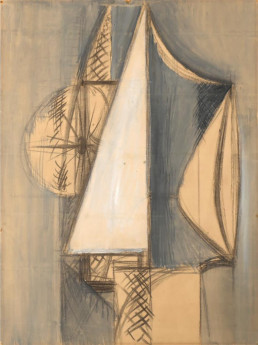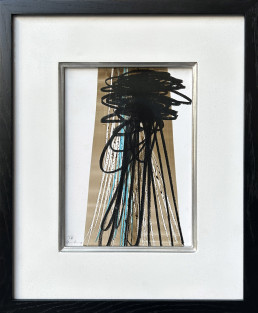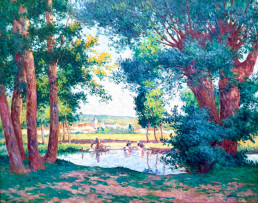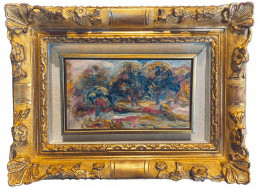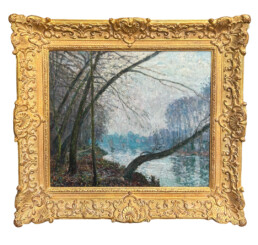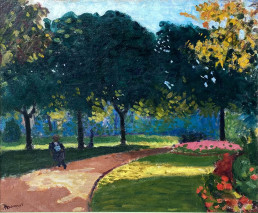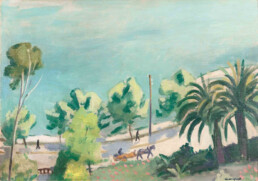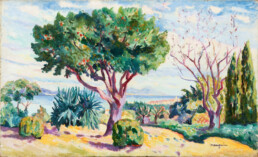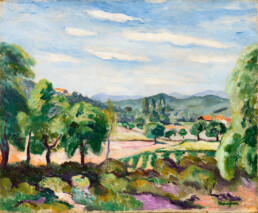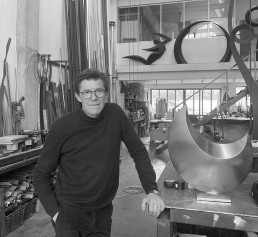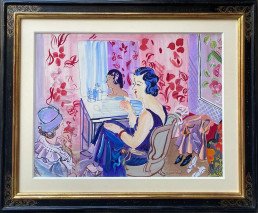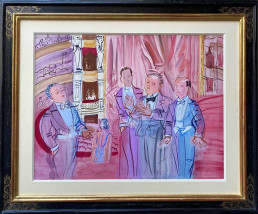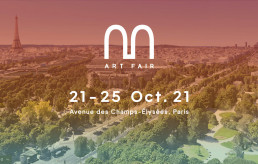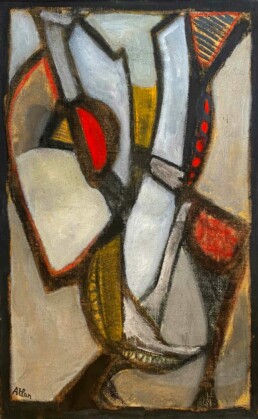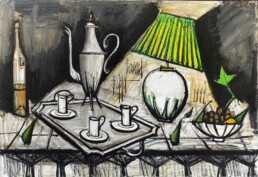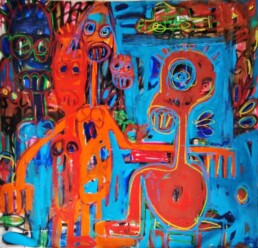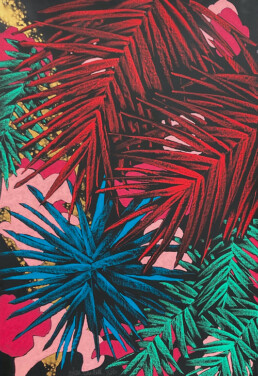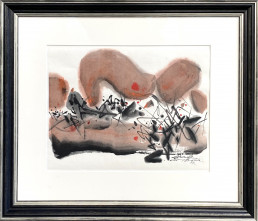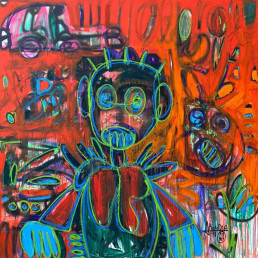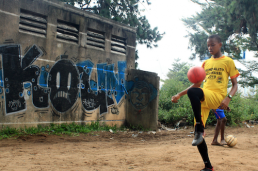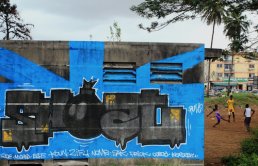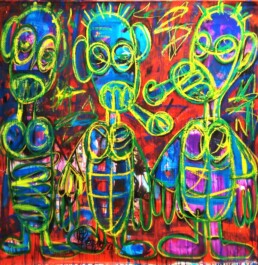Hans Hartung : Exploring his Lyrical Abstraction
Hans Hartung, born in Germany in 1904, is a central figure in 20th-century abstract art. His work, marked by a relentless search for new forms of expression, bears witness to his creative genius and lasting influence on modern art. Through his works, Hartung explored a variety of techniques and styles, constantly evolving and pushing back the boundaries of abstraction. This article explores three key works by Hartung, produced in 1939, 1976 and 1988, illustrating his artistic journey and the evolution of his technique.
A Work of 1939: Geometric Inspiration
In 1939, the year of his marriage to Roberta Gonzalez, Hans Hartung created a landmark body of work that testifies to his brief exploration of geometrically inspired abstraction. This period of his work is characterized by a move away from his usual abstract representations, concentrating instead on shapes, lines and structures.
This 1939 piece is emblematic of this experimental phase. It presents a balanced composition of geometric shapes and lines drawn with great precision and delicacy, reflecting Hartung’s meticulous search for a new aesthetic. Shades of gray and beige dominate the palette, creating a sober, elegant ambience that emphasizes the purity of form.
The work also shows the influence of modern European art, notably Cubism and Constructivism, movements that had a profound impact on Hartung’s quest for artistic innovation. Although it is not certain whether this piece was a wedding gift, it represents an intimate link between his personal life and his artistic evolution.
To fully appreciate this work, one must consider not only its visual beauty but also its historical context. It marks a milestone in Hartung‘s career, characterized by a constant quest for innovation and artistic expression.
Abstraction in the 70s: a period of change
In the 1970s, Hans Hartung found himself in a transitional period marked by the transition from the scratch techniques of the 1960s. This period is characterized by a style of abstraction in which he uses energetic, spontaneous brushstrokes to express a new intensity and freedom compared to his early geometric explorations.
This 1976 work, characterized by swirling black lines and bursts of vibrant color, is a good illustration of this period. Here, Hartung adopts a gestural approach, where each brushstroke seems a direct extension of his state of mind. The bright blue running through the work adds a depth and vitality that contrasts magnificently with the darker tones.
Blue is not chosen at random; it demonstrates Hartung‘s ability to use color to evoke different atmospheres. A symbol of calm and serenity, blue blends with the turbulence of black lines, creating a captivating visual tension.
This work also illustrates Hart’s move away from the scratching technique typical of the 60s, and a new approach to abstraction.
Hartung‘s lyrical abstraction reflects a quest for freedom and pure expression. By freeing himself from formal constraints, he succeeds in conveying feelings and sensations with a rare immediacy. His 1976 work embodies this quest for direct, instinctive artistic communication.
A Work from 1988: Hartung's Ultimate Achievement in Abstraction
The 1980s marked the last period of his career, the ultimate culmination of his abstraction, which was very different from his earlier paintings. From 1986 onwards, Hartung was very weak and could no longer manipulate the instruments he usually used to paint. He then turned to innovative techniques, working on the projection of paint streams using zip-lines, airless spray guns and garden sulfate machines.
This 1988 work, created just after the death of his wife Anna-Eva Bergman in 1987 and the year before his own death, is typical of his work during this period. Hartung emancipated himself from traditional forms, articulating his work around two recurring vocabularies: interlacing and zone-by-zone color. He creates a background with a gun that sprays color in a nebulous manner, then draws over it with a garden sprayer. The colors, dominated by shades of blue and white, show a technical mastery and increased sophistication in his use of materials. The contrast between bursts of blue and white textures creates a rich visual composition, illustrating the evolution of his lyrical abstraction. Subtle fluorescent yellow speckling also appears in the work, adding a touch of luminosity and depth, and demonstrating once again Hartung‘s ability to exploit every nuance to enrich his compositions.
Hartung approaches the new tools with the same curiosity and rigor he had for the more traditional techniques. He experimented, moving from discovery to mastery, physically memorizing the possibilities offered by these new tools.
The 1988 work reflects this technical exploration, with the rapid, controlled execution that characterizes his style. Speed of execution is an essential feature of this work. The tools used demand a double mastery: that of gesture and that of time. Hartung, who has always experimented with the temporal dimension of his techniques, knows perfectly well how to play with these elements to create dynamic, moving compositions.
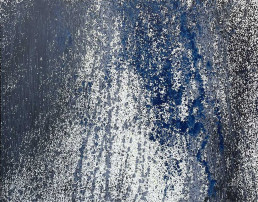
Hans Hartung left an indelible mark on abstract art, constantly exploring new forms of expression. His works from 1939, 1976 and 1988 bear witness to his stylistic evolution and his capacity for constant innovation. Through his various periods, Hartung always sought to capture the essence of emotion and movement, leaving a rich and varied artistic legacy.
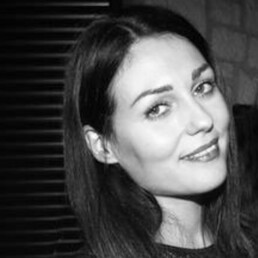
Céline FERNANDEZ
With 15 years' experience in marketing and communications, Céline has worked for major companies such as Public Système, Groupe Galerie Lafayette and several communications agencies. For over 5 years, she has been managing the gallery's communications through the website, social networks and traditional media.
French Landscapes: Impressionist and Postimpressionist
Rediscovering French horizons: a journey from Impressionism to Postimpressionism.
Galerie Hurtebize is proud to present its exhibition, “French Landscapes : Impressionnism and Postimpressionnism“, offering a fascinating immersion in French landscapes as interpreted by the emblematic figures of these artistic movements. As we celebrate the 150th anniversary of Impressionism, our exhibition takes on a special resonance. A century and a half ago, a group of daring painters broke with convention to explore new ways of capturing the moment on canvas, giving birth to what would come to be recognized as one of the greatest artistic revolutions in history.
This exhibition is a vibrant tribute to a movement that changed the course of art forever. It invites visitors to contemplate works that continue to embody the spirit of innovation and freedom of expression that animated these revolutionary artists. As you browse through the exhibition, you’ll feel the effervescence of that seething period, when every brushstroke testified to a passionate quest to capture the ephemeral.
Our collection is a celebration of the diversity and richness of the French landscape, and a recognition of its central role in the development of these two movements that had a lasting impact on the world art scene.
Works by Pierre-Auguste Renoir, Alfred Sisley, Albert Marquet, Henri Manguin, Henri Martin and others interact within the exhibition, offering a rich and diverse representation of the French landscape. They celebrate land, water and sky, capturing with a personal touch the beauty of France that continues to fascinate and inspire.
It is with great pleasure that we open our doors to reveal canvases where nature is sometimes gentle and soothing, sometimes lively and tumultuous. The works selected for this exhibition celebrate the splendor of the countryside, the poetry of villages and the wildness of the French coastline.
Lumières Fugitives: When the Impressionists Painted the Moment
Pierre-Auguste Renoir the master of light
The masters of Impressionism, such as Pierre-Auguste Renoir with his famous “Maison Blanche”, revolutionized the perception of light and color, opting for rapid, colorful strokes that capture the essence of the moment. The work presented here, “Paysage“, depicts a view of the olive groves of Cagnes-sur-Mer, a vibrant testimony to the last years of the artist’s life. Renoir, in search of light and warmth for his old age, had settled in the south of France, and it was here, in the heart of luminous Provence, that he captured the immortal beauty of his olive groves at the Domaine des Collettes. The work is a whirlwind of vivid color and movement, where the brush dances and plays with light, evoking the warm breeze of a Mediterranean afternoon. The palpable texture of the paint and the spontaneity of the brushstrokes suggest an artist in full communion with his environment, capturing the vibrant essence of twisted trees and the generous earth that nourishes them. Through these almost abstract forms, we can feel the deep and lasting impact that nature and this particular corner of France have had on the artist.
Alfred Sisley, the pure Impressionist
Alfred Sisley‘s “Matinée d’Octobre près du Port-Marly” is a gentle, melancholy view of a river landscape, with trees leaning gracefully over the water, bathed in the morning mist of early autumn. His work captures the transient essence of light and atmosphere with a subtlety that is the hallmark of the great Impressionist masters. This work by Alfred Sisley is interesting for its location, the town of Port-Marly, at the heart of the artist’s creation. Its counterpart is on show at the Städel Museum in Frankfurt am Main, Germany.
Albert Marquet and the beginnings of Post-Impressionism
Albert Marquet, known for his views of the port of Saint-Tropez, captures the reflections and changing nuances of the water with finesse. “La Route de l’Estaque” and his “Jardin du Luxembourg” scene bring a more structured, colorful perspective, typical of the evolution towards Post-Impressionism. He balances form and color, creating scenes that are both immediate and timeless. Marquet gives us urban and coastal landscapes tinged with a poetic tranquility, a distinct luminous quality that reflects the serenity of a scene from everyday life.
Colors and contours: The vibrant legacy of the Postimpressionists.
Henri Martin and his free pointillist style
Alongside them are the postimpressionists, whose work, at the heart of Henri Martin‘s “Printemps à la Bastide du Vert” exhibition, shimmers with timeless grace, inviting contemplation. This artist, less popular than his Impressionist counterparts but just as captivating, brought Post-Impressionism to a lyrical and intimate scale. The painting presented here, a depiction of the Bastide du Vert, captures with poetic delicacy the church and poplars that stand like sentinels around the village, under a light that seems to pulsate with the rhythm of rural life. Martin’s technique, with its pointillist strokes and rich palette, transports us into an atmosphere imbued with tranquility. It’s not just technical skill that reveals itself before our eyes, but a deep understanding and love of the French countryside that manifests itself in every part of the canvas. Martin, with his unique ability to translate the peaceful majesty of the landscapes of south-western France, offers us an almost ethereal vision of nature. His work is a call to feel the harmony that emanates from the fields, trees and old stone walls of these places he so cherished.
Henri Manguin and the colorful exuberance of Fauvism
The exhibition would not be complete without the work of Henri Manguin, an outstanding colorist who followed in the footsteps of the Fauvists with his own sensibility. The year 1921 saw the birth of his work “Paysage autour de Gassin“, a vibrant summer canvas, where warm hues and deep shadows tell the story of a Provence both wild and domesticated. A few years later, in 1925, Manguin paid tribute to the beauty of the Côte d’Azur with “Vue sur le Golfe de Saint-Tropez“. This piece captures the essence of a region bathed in light, where sky and sea embrace in a harmony of blues and greens, punctuated by the reds and yellows of the trees and flowers that adorn this coastal landscape. These two paintings testify to Manguin‘s talent for immortalizing the subtle nuances of southern light. Contemplating them, you can almost feel the warmth of the Mediterranean sun and the scent of pine trees. Their presence in the exhibition offers a fluid transition between the softness of Impressionism and the colorful exuberance of Fauvism, showing how French landscapes continued to inspire and transform art, even after the Impressionist era.
We invite you to let yourself be carried away by this pictorial odyssey. Observe how landscape transcends its simple representation to become a vehicle of emotion and expression. It is a universal language, an adventure in perception where the canvas becomes a meeting place between the viewer and the artist’s inner vision.
Franch Landscape: Impressionnism and Postimpressionnism opens up a silent but powerful dialogue between works and visitors. The gallery awaits you for a unique experience that promises to enrich your understanding of art and make you see France in a new light.
The Galerie Hurtebize team looks forward to seeing you.

Céline Fernandez
With 15 years' experience in marketing and communications, Céline has worked for major companies such as Public Système, Groupe Galerie Lafayette and several communications agencies. For over 4 years, she has been managing the gallery's communications through the website, social networks and traditional media.
Francis GUERRIER, the Nature-Sculpture
From a line of artists, from his grandfather to his two daughters, Francis Guerrier was born in 1964 in Marseille and lives today in his childhood home in Eygalières, which he has decorated with a huge studio bathed in light.
More than the mastery of artistic techniques, his family environment transmitted to him a strong sensitivity to art. But he waited until the death of his painter father Raymond Guerrier to be able to call himself an artist and he chose sculpture, turning his back on the painting practiced by the Guerrier family for two generations.
He left for Paris at the age of 19 and, the following year, began his creative activity with the architect-scenographer Pierre-Henri Magnin, who introduced him to the world of decor and scenography and whom Francis considered his master.
He got married and became a father at a very young age, which led him to create his own company for the creation of sets and scenography for events at the age of 25 in order to provide for his family’s needs more serenely. For ten years, in order to meet his clients’ wishes, he had to master many tools and media: video, laser, sound and light installations, but also construction materials, wood and steel. A rich experience but restrictive because it is time-consuming and limiting: he wants to expand his field of creation, give free rein to his imagination and no longer simply honor orders.
In 2000, at the age of 36, he sold his company and sailed for 4 months in the Mediterranean to discover the sites listed as World Heritage by UNESCO, from Italy to Egypt through Syria. On his return, he knew he wanted to be a sculptor. He then made a break in his professional career, which was nevertheless flourishing, in order to feel in phase with his deepest values and to respond to the imperative need to return to his roots. At first, he settled in Paris in his grandfather’s studio, which was also André Derain‘s studio. He then discovered the painted work of his grandfather and this universe became his main inspiration. In 2002, he held his first exhibition of his sculptural work around the sky, dreams and memory, where he integrated light into the steel, wood, glass and copper that make up his creations.
But Francis Guerrier has a need for grandeur and dreams of creating a monumental work “that puts man in his place”. He also feels that nature and the light of the south are necessary for him. In 2015, he moved with his second wife to Eygalières and rediscovered his roots. While still working as a set designer to satisfy his passion for theater, he further developed his know-how and his own technique and could finally tackle the realization of sculptures of impressive dimensions, such as his 12-meter high Feather. In 2005, the Galerie Guigon in Paris allows him to present his new work of steel based on the folding and the curve.
"I don't model my sculptures, I work from a sheet of metal that I cut and shape. By honoring the material, by respecting its energy, its spring, its possible curvature, I reach balance, harmony, I find nature... And it is nature, in its purity but also its complexity, which is my first inspiration. Curves, moons, trajectories and spirals so often present in nature, from shells to galaxies, are my writing. I do not seek abstraction, but on the contrary, to get closer to the original forms."
The black steel sheet becomes his medium of choice. He developed a technique of incising the metal and cold bending of flat plates by which he seeks to honor the material and find balance and harmony after the struggle. His Euclidean forms are inspired by nature, the cosmos and the stars, and volume is created through folding.
"It is with the black steel sheet, hard and springy, that my exchange with the material is the strongest. My main work with steel consists of cutting it, but above all, bending it into a curve. If I draw, it is the steel that takes shape and creates its volumes by its energy."
Monumental and yet light, black and yet luminous, soft and angular, his sculptures with pure, sober and elegant lines are the result of a manufacturing process very personal to the artist who lets himself be guided by the resistance of the material in order to find a true synergy between the work and its environment and offer new perspectives in the landscape.
"From this struggle with metal, I win if I tame, if I honor the material, I reach balance, harmony, I find nature..."
Strong and energetic while being pure and sober, Francis Guerrier’s sculptures seduce us with the voluptuousness of their curves and the momentum of their lines. A true link between earth, sky and sea, they reflect the personality of their creator: “Head in the stars and feet on the ground”.
Nothing found.
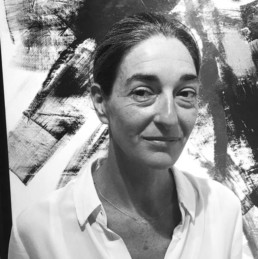
Maud Barral
After 15 years spent as the assistant of the famous gallerist Jean Ferrero, whose gallery has been the main center of creation for the artists of the School of Nice and the Nouveaux-Réalistes movements, Maud has then opened for 5 years her own gallery, supporting contemporary young artists. Then, she has decided to enter the Galerie Hurtebize, in 2015.
Raoul Dufy, Mon Docteur le Vin, 1936
In 1822, Nicolas revolutionized the world of wine by bottling precious nectars for home consumption.
Since 1930, in order to thank its most loyal customers, Etienne Nicolas publishes every year for Christmas a catalog illustrated by an artist. Today, this long series of 35 books is a real treasure for art and wine collectors. Over the years, Kees Van Dongen, Jean Hugo, Bernard Buffet, André Derain, Bernard Lorjou, Raymond Guerrier and Raoul Dufy, among others, have collaborated in the creation of these brochures.
We recently had the opportunity to acquire an exceptional set of 7 original drawings by Raoul Dufy reproduced in the 1936 catalog published by Nicolas & Draëger Establishment, a famous printer and engraver in Montrouge, entitled “Mon Docteur le Vin“. The 20 watercolors created for the occasion were the subject of an exhibition that same year at the Galerie Bernheim-Jeune in Paris. We also found an original edition of the book, signed by Dufy.
From the first page, the tone is given: “My Doctor the Wine? Yes, because his precepts, as old as the world, are justified more and more each day by science. After the First World War, Marshal Pétain, in his introduction “Homage to Wine”, indicates that “wine has been, for the combatants, the beneficial stimulant of the moral forces as well as the physical forces – thus it has largely contributed, in its own way, to the Victory”. And the benefits of wine are listed in the summary: vitamins and radioactivity of wine; wine against typhoid fever, depression, anemia, diabetes or obesity; wine for the kidneys, the maintenance of youth and aesthetics, character and morale; indispensable to writers, artists and athletes. And finally, wine makes men handsome and promotes longevity! The quotation of Professor P. PIERRET will serve as a conclusion: “Wine carries with it cheerfulness, strength, youth and health. It is sunshine in a bottle”. So, who better than Raoul Dufy to illustrate such a book?
« If I could express all the joy that is in me » Raoul Dufy
Painter of optimism, festivity and worldliness, Raoul Dufy has a marvelous look at the world and transmits through his colorful and poetic painting, a joyful feeling of well-being and life. As Pierre Camo says so well in “Dufy, l’Enchanteur” (ed. Marguerat, 1947) “Everything is fresh, lively, clear, joyful like spring in nature or youth in life”. The titles given to exhibitions and various tributes dedicated to the artist testify to this: “Raoul Dufy. Le Plaisir” (Museum of Modern Art, Paris, 2008); “Raoul Dufy. A Spectacle of Society” (Connaught Brown Gallery, London, 2016); “The Colors of Happiness” (Jean Cocteau Museum, Menton, 2017); “The Lightness of Raoul Dufy” (Angladon Museum, Avignon, 2017).
His style corresponds exactly to the spirit of “Mon Docteur le Vin“, a work linking humor, finesse and precision.
At the age of 13, the young Raoul imposed his choice to become a painter on his family of musicians and left his native Normandy to train at the Ecole des Beaux-Arts in Paris. Influenced at first by the Impressionists and then by the brilliance of color in the Fauves, he admired Cézanne more than anyone else and it was in the Provençal lands dear to Cézanne that he found his own language and developed his principle of “light-color”.
"In 1919 Dufy suddenly became Dufy. The hand is freed, his line gains in flexibility and strength. Above all, he devoted himself to watercolor, which allowed him to render the beauty of the landscapes of Provence, their transparencies and their lights. (...) His painting acquires a new dynamism. The forms gain in lightness and balance. His drawing is faster, more exalted. He feels a desire to create which reflects all his joy of artist conscious to have reached maturity and all the happiness of a world henceforth liberated ".
Fanny Guillon Laffaille
The essential characteristics of Raoul Dufy’s style were born and would never leave him: dissociation of line and color; sketched but dynamic and lively figures; chubby and voluptuous curves; simple, supple and expressive lines; flamboyance of color that becomes light. In 1936, the year of the publication of “Mon Docteur le Vin”, Dufy was already known worldwide and had personal exhibitions in New York, Brussels, Prague…
Endowed with an exceptional gift of drawing and coloring, it is through drawing and more precisely through watercolor that he reveals his true talent and releases his lively and graceful gesture. From the 1930s, Dufy gave more and more space to his graphic work and worked on the possibilities offered by the use of his “puddles of color” that precede his line.
"Any drawing by Raoul Dufy is in some way his signature
and what is agreed to call inimitable signature."Jean Cocteau
Raoul Dufy does not seek to represent materiality but offers a very free and subjective interpretation of his subject where reality and imagination intersect. If one finds recurring themes and motifs in his work (orchestras, landscapes, portraits, horse races…), the artist is eclectic and expresses himself through various media, multiplying experiences: drawing, painting, sculpture but also decorative arts, illustration, tapestry, sets and costumes. His calligraphic surety, the simplicity and purity of his subject, his extraordinary sense of composition, the suppleness of his lines and the brightness of the colors dissociated from the line will remain recognizable among all, whatever the chosen support.
A relentless worker, he produced no less than 4,000 drawings and 2,000 paintings, among other ceramics, fabrics, tapestries… a fruitful career if ever there was one, and success and international recognition were at hand! One year before his death, in 1952, the XXVIth Venice Biennale awarded him the Grand Prize for Painting to crown his work.
Discover an extract of the book “Mon Docteur le Vin”.

Maud Barral
Après une expérience de 15 ans passés aux côtés de Jean Ferrero, directeur de la galerie historique de l’École de Nice et des Nouveaux Réalistes, Maud a ensuite défendu la jeune création contemporaine durant 5 ans, au sein de sa propre galerie, avant de rejoindre l’équipe de la Galerie Hurtebize en 2015.
Venet's drawing
Bernar VENET, a French artist born in 1941 and living between France and the United States since the 1960s, is today known worldwide for his sculptures and recognised for his monumental installations in the public domain.
We would like to focus here on another part of his compositions: his graphic work. We will base this article on two works on paper recently acquired by the gallery, which perfectly illustrate the importance of drawing in the sculptor’s creative process.
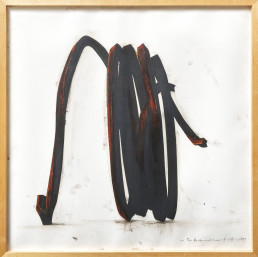
Bernar VENET – Two Undetermined Lines, 1989 – Oil pastels on paper – 76.2 x 76.2 cm
“First, I have a vision. Then I make a small drawing with the main precaution being the question of proportions “.
From his first artistic experiences, Bernar VENET gives the drawing a predominant and omnipresent place. From mathematical formulas written with ink on large papers, to industrial technical diagrams presenting the physical characteristics of an object produced and shown at the same time in volume, Venet’s graphic works are inseparable from his sculptures.
Like many artists, drawing is the first stage in Bernar Venet’s work and he will build his sculptural project through it. Moreover, the sculptor can be felt behind each of the artist’s sketches: the relief and perspectives make each drawing a wall sculpture. The flat work seems to be already present in volume, it seems to come out of its frame. Here, the preparatory drawing is not a sketch but a fully-fledged, finished work that stands on its own and presents us with the essence of the subject to which Venet will give life. The movement, relief, texture and colours of the pastel give us the grainy, rusty aspect of the Corten steel that will constitute the material of the sculpture to be born. The attention is already entirely concentrated on the form, no superfluous detail disturbs the eye. Ingres gave this advice to his students: “Have the figure you want to represent entirely in your eyes and in your mind, and let the execution be nothing more than the accomplishment of this already possessed and preconceived image”. With a lively, sober, powerful and elegant gesture, Venet goes straight to his goal, follows his Line, a central element of his work since the 1960s, the volume of which he already feels, and remains faithful to what he calls the principle of equivalence, which makes it possible to transmit the same content through different channels.
The second stage is the casting of the sculpture in black or Corten steel according to the drawing. Then, in a third step, the artist will try to give yet another vision of his work, this time from a photographic view of his sculpture.
In Venet’s case, there is an absolute circularity between drawing, sculpture and photography. The form and its metaphors are contiguous and reflect the artist’s desire to achieve the absolute object, one whose aspect refers only to itself without expressiveness, totally neutral, depersonalised. This was already the aim of Bernar Venet during his first artistic experiments based on the use of diagrams and mathematical formulas, or also through his performance around the “coal pile”: “The charcoal, placed freely in a heap, freed the sculpture from the apriorities of the composition imposed by the artist. The material, always poor (coal, tar, steel…), used for its own capacities, decides on its own form which will be different with each use, thus allowing the artist’s personality to disappear behind his work. Through the raw and industrial materials he chooses, Venet further emphasises the radical and self-referential nature of his research: the work must speak only of itself and not of the artist. It is on this monosemia principle that he has based his thinking since the beginning.
Bernar VENET – Indeterminate Line, 2016 – Photograph and charcoal on paper – 220 x 153 cm
This Indeterminate Line, created in 2016, is entirely representative of the style and strength of Venet’s work: at once minimal and monumental, even colossal, the line takes over the space with its presence and movement. Here we are faced with what could be described as the third stage of his work: after the preparatory drawing and the making of the sculpture, the artist seeks to give another vision of this volume. He then chooses an angle of view which he fixes photographically and reworks into a flat. The photo is then cut out following the contours of the sculptural form, pasted onto a large white paper and reworked with charcoal. This tool, made from charcoal (well, look at that…), used since prehistoric times in cave art, which is as raw as it gets, is generally associated with preliminary work because it is very easily erased. Here again, Venet goes against the grain. He glorifies charcoal through its use in the final work. The specific characteristics of charcoal allow him to add depth to his work and to play with light by varying the value of the black, more or less blurred. The rough and raw texture of charcoal can also recall the feel of steel. And the circle is complete!
«Expanding the field of the visual world»
Bernar Venet became an artist at a time when lyrical abstraction was exploding in France and conceptual art in the United States. He did not adhere to these movements and sought something else to broaden the field of creation. He therefore found his inspiration elsewhere, in disciplines outside the art world such as mathematics, geometry and physics.
His work will develop around a theme: the Line, which will become straight, curved, indeterminate before being transformed into Arcs and Angles. From the outset, his work was radical, even austere, compared to the generally lyrical and colourful abstract art of the 1960s. Using black and industrial materials, with a minimal and deliberately inexpressive gesture, he wanted to achieve the absolute object, one whose form would refer only to itself and not to the artist’s “style”. He remained faithful to the initial principles of his creation (principle of equivalence, refusal of aesthetics and monosemia principle) on which he based a protean work: paintings, sculptures, drawings, photographs, architecture, poetry, sound works, films…
A major artist of conceptual and minimal art, the father of informal art born with his “coal pile “, Bernar VENET is today present in some sixty museums throughout the world and receives numerous public and private commissions for permanent and often monumental installations.

Maud Barral
After 15 years spent as the assistant of the famous gallerist Jean Ferrero, whose gallery has been the main center of creation for the artists of the School of Nice and the Nouveaux-Réalistes movements, Maud has then opened for 5 years her own gallery, supporting contemporary young artists. Then, she has decided to enter the Galerie Hurtebize, in 2015.
MODERNE ART FAIR - The Gallery is back in the Parisian fairs
Dear Friends, Dear Collectors,
After almost two years without a fair, we are really impatient to come and meet you in Paris for our participation in MODERNE ART FAIR, a fair that replaces ART ELYSEES which we have been following for more than 10 years. It is therefore out of loyalty, but also to make up for the lack of our Parisian contacts, that we are back on the art scene of our dear capital.
These last months, frustrated by not being able to participate or organize events abroad, we have taken advantage of this flexibility in our schedule to take a more serious interest in the Contemporary Art market. We remain faithful to our passions and attached to the purchase and sale of major works by artists of the 1950s and will present from 21 to 25 October paintings by Jean-Michel ATLAN, Bernard BUFFET, André MARFAING, Georges MATHIEU, Jean MIOTTE … artists who have made the reputation of our gallery.
Also, we will hang on these temporary walls our contemporary favourites, some already known and recognized internationally and others that we wish to make you discover : ABOUDIA, LEE Bae, Julien COLOMBIER, Jan KOLATA, Michel MOUSSEAU, Jean-Jacques MARIE …
This year, we will also devote a part of our stand to the presentation of works on paper of great signatures. Drawings by Joan MIRÒ, Henri MICHAUX, CHU Teh-Chun and Serge POLIAKOFF, acquired from private collections and accompanied by certificates of authenticity from approved experts, will enable you to appreciate the finesse of the line or the mastery of the colours of these artists and to consider the work on paper as a work in its own right and not as a preparatory study.
This new selection offers us the possibility of presenting quality works adapted to all types of budget. Do you want to buy a work of art at a low price or do you want to think about a financial investment? We are here to guide you, advise you and meet your expectations.
We look forward to seeing you on the Champs-Elysées, a stone’s throw from the Grand Palais Ephémère and the FIAC, to present our latest acquisitions and to see you again!

Maud Barral
After 15 years of experience working with Jean Ferrero, director of the historic gallery of the École de Nice and the Nouveaux Réalistes, Maud then defended the young contemporary creation for 5 years, within her own gallery, before joining the Hurtebize Gallery team in 2015.
Aboudia, a committed artist and spokesperson for the youth of Abidjan
From Abidjan to Brooklyn
Abdoulaye Diarrasouba aka ABOUDIA was born in 1983 in Abidjan, Ivory Coast. He became a painter, against the advice of his parents and teachers who predicted a career as a “Tagger”. In 2003, he graduated́ from the Centre d’Art Technique des Arts Appliqués in Bingerville.
Aboudia was spotted in 2011 by critics for his works that bear witness to the violence in Ivory Coast during the civil war and the numerous riots that took place after the presidential elections. His works are distributed throughout the world thanks to the photographs taken by Finbar O’Reilly for Reuters, and are very quickly exhibited at the Jack Bell gallery in London in 2012 and at the Cécile Fakhoury gallery in Abidjan in 2013, where he collaborates notably with the Ivorian artist Frédéric Bruly Bouabré. His presence in the exhibition “Pangea II: New Art From Africa and Latin America” at the Saatchi Gallery in London in 2014 exposed him alongside an emerging generation of young African and South American artists. His work is frequently shown in solo exhibitions in Abidjan, London, New York, Paris and Dakar. He created the Aboudia Foundation in Bingerville in 2018 to support children and young artists.
Aboudia’s work can be found in numerous collections, including the Saatchi Gallery in London, the Nevada Museum of Art in Reno, USA, and the Tiroche DeLeon collection in Israel.
His last public sale record was in March 2021 at Christie’s in London. A work from 2013 was sold for 189,000 euros.
Today he lives between Asu (his home town) and Brooklyn.
The foundation of his style and technique
He began by working on large canvases measuring 3 x 4 metres. He continues to distinguish himself by creating monumental formats of 30, 60 meters.
He defines his style as urban, “street art that speaks of graffiti“. Influenced by the graffiti of Abidjan and the traditional statues of West Africa, he is naturally compared to Jean-Michel Basquiat. The famous artist also uses the term “Noutchy”, which refers to the combination of several Ivory Coast languages and French, to characterise his work. His art is a bridge between contemporary Western aesthetics and the problems of a changing African society.
In his work, which has a strong biographical and protest content, he reveals a poor facet of Abidjan with its modest neighbourhoods, far from the idealised images of Africa. His greatest source of inspiration are the children of the disadvantaged neighbourhoods of the Ivorian capital who have not had an education and dream of better days. The subject matter of his work focuses mainly on this theme because he considers children and education to be the pillars of a nation. He says that it was while walking down the Treichville district in Abidjan that he observed children expressing themselves on the walls by making graffiti. He watches this little boy who wants to be a doctor, drawing himself with a white coat. Another little girl who dreams of being an actress immerses herself in her imagination by drawing a scene from a film. This is how he creates his identity, by borrowing the writing of these children with this naive and colourful gesture full of vitality and energy. He puts himself in the shoes of a 5 year old child to create and uses materials such as cardboard, charcoal or even chalk, to remain close to the reality of these children and respect their history.
Copyright : Mobio Hermann Apohi, photographer based in Abidjan, Ivory Coast – https://www.abidjangraffiti.com
A cosmopolitan artist, he constructs his work as an anti-violence manifesto with very few technical means. He acts as a spokesman for the deprived youth of Abidjan and highlights their cause through his work while asking fundamental questions about the nature of the world.
“If we decide to wage war, why can’t we decide to make peace and help people sleeping in the street? We have that power. What is wrong with this world? That’s the question I’m asking myself and I’d like to find the answer.” 2
Copyright : Mobio Hermann Apohi, photographer based in Abidjan, Ivory Coast – https://www.abidjangraffiti.com
He also sees art as a way to bring people together.
“Art is something that travels, brings together all social classes.” 3
Copyright : Mobio Hermann Apohi, photographer based in Abidjan, Ivory Coast – https://www.abidjangraffiti.com
A series of three works can be seen on the gallery's walls
The Hurtebize Gallery has the will to diversify and to propose a new palette of international contemporary artists. This change of direction will focus on several areas, including African artists and a return to figurative art. Aboudia, a young up-and-coming artist in full explosion, is representative of this movement and was a real favourite for the gallery. We have included a series of three square works in orange that can be seen on our walls. These works mix techniques where paintings, pastels, collages as well as materials found in the street are superimposed to represent scenes of life in the Abidjan neighbourhoods. Characters drawn with thick pastel strokes cover shreds of magazine pages and other elements to catch the eye of the viewer.
At the centre of his discourse are worried faces witnessing a dark urban chaos that occupy almost the entire composition. What is striking is the brutal and violent reality of Africa that his works show, which contrasts with the vitality and cheerfulness that emanate from his art.
“Through colour I illustrate the vitality of these children. I treat a negative subject with joie de vivre, colour and enthusiasm. 4
Aboudia’s works will be presented at the Moderne Art Fair, a new event that replaces Art Élysées, from 21 to 25 October in Paris.

Céline Fernandez
With 14 years of experience in marketing and communication, Céline has worked for large companies such as Public Système, Groupe Galerie Lafayette and several communication agencies. For the past 2 years, she has been managing the gallery's communication through the website, social networks and traditional media.


